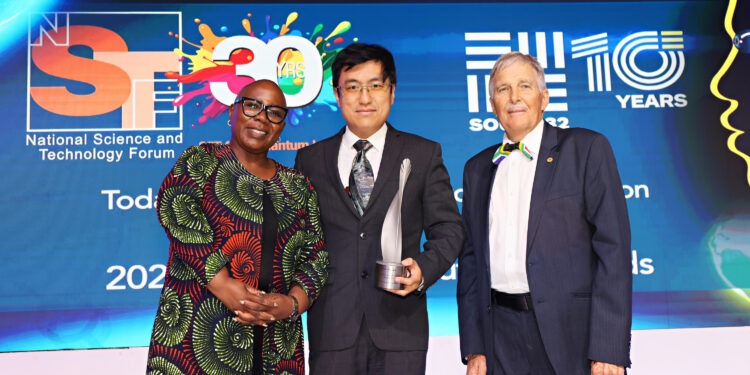On a clear Southern sky evening, when stars wink their distant stories, we pause and look up—because on International Astronomy Day, we are reminded that the cosmos is both our mirror and our mystery. This 4 October, as the world celebrates humanity’s love for the sky, South Africa turns its gaze toward one of its own: Prof Yin-Zhe Ma, newly honoured with the TW Kambule-NSTF Researcher Award at the 2025 NSTF-South32 Awards, often called the “Science Oscars” of South Africa.
Prof Ma’s recognition is not just a personal triumph. It is a testament to South Africa’s growing imprint in the frontiers of cosmology: in dark energy, missing matter, the structure of galaxies, and the very framework of the universe itself.
A Lifetime of Looking Up
Yin-Zhe Ma is more than an academic title or a name on paper. He is Full Professor and Head of the Astrophysics Group at Stellenbosch University, and holds the Stellenbosch–Groningen Joint Research Chair in Computational Astronomy. His journey began in Nanjing University (China) in physics, then through the Chinese Academy of Sciences, and ultimately a PhD in astronomy at Cambridge University (2011).
He has held fellowships at major institutions in Canada and the UK, later joining UKZN in 2015 to build a thriving research group before moving to Stellenbosch in 2023 to establish and lead its astrophysics division.
Even in his public lectures, like his inaugural lecture “Unravelling the mysteries of the universe” delivered in August 2024 at Stellenbosch, Prof Ma speaks not only of equations and data—but of wonder, humility, and a conviction that the cosmos must, one day, become part of our shared storytelling.
Exploring the Deepest Questions
What makes Prof Ma’s work so compelling is how he blends theory and observation, bringing data to bear on the most profound questions:
-
Where are the “missing baryons”—the ordinary matter we know must exist but often cannot see?
-
How does dark energy drive the accelerating expansion of the universe?
-
How do galaxies form, cluster, and trace the invisible scaffolding of dark matter?
-
What can the cosmic microwave background, hydrogen surveys, and 21-cm intensity mapping reveal about the early universe and the epoch of reionization?
In his research group at Stellenbosch, Prof Ma works across radio cosmology, extragalactic astronomy, large scale structure, and observational probes of inflation and dark energy. His team is actively involved in South Africa’s MeerKAT telescope, the SKA (Square Kilometre Array) science working groups, HERA (Hydrogen Epoch of Reionization Array), and other global collaborations.
His published work is equally prolific. Over 130 peer-reviewed papers, more than 29,000 citations, and an influence that crosses continents.
A Unique National & International Bridge
Prof Ma’s recognition at the NSTF-South32 Awards does more than celebrate an individual—it highlights South Africa’s place in global science. The award, often described as the “Science Oscars” of South Africa, acknowledges research that not only advances academic boundaries but also resonates with society.
In launching the Stellenbosch–Groningen Joint Research Chair in Computational Astronomy, Prof Ma is helping create a pipeline of African scientists working at the frontier, tied into global networks, with access to shared facilities—bridging local talent to cosmic discovery.
He is also deeply committed to mentorship: shaping the next generation of South African astrophysicists, enhancing capacity, and ensuring that African voices are contributing centrally to cosmic narratives.
When Science Moves the Heart
Pause for a moment. Imagine an African child in a rural village, looking up at a sky flooded with stars. Imagine explaining: “We built a telescope here. We measure the whispers of hydrogen gas. We track how the universe expanded.”
When Prof Ma speaks of “missing baryons repelled from dark matter halos into cosmic filaments and voids,” he’s not just speaking jargon. He is describing where parts of you, me, and every atom have been throughout cosmic history.
He once said, “This award is a wonderful recognition of my curiosity-driven research … enriching human experience and expanding horizons.” It is fitting, then, that on International Astronomy Day, we honour a scientist who reaches beyond institutions and enters the realm of our common dreams.
Call to Look Up
On 4 October 2025, as we celebrate astronomy around the world, the NSTF encourages all South Africans to dare to look up:
-
Attend stargazing events, planetarium shows, and open observatories
-
Visit science centres, universities, and astronomy clubs
-
Support astronomy education in under-resourced areas
-
Share the beauty of the night sky, and the stories of those who study it
When we teach a child to see Jupiter’s moons, or the Milky Way’s luminous band, we gift perspective. We remind ourselves that Earth is small in space—but our curiosity, imagination, and capacity to understand are boundless.
Prof Yin-Zhe Ma’s life work reminds us: when we explore the universe, we explore ourselves.
Let us celebrate him. Let us celebrate the night sky. And let us carry forward the wonder that unites us all.



































